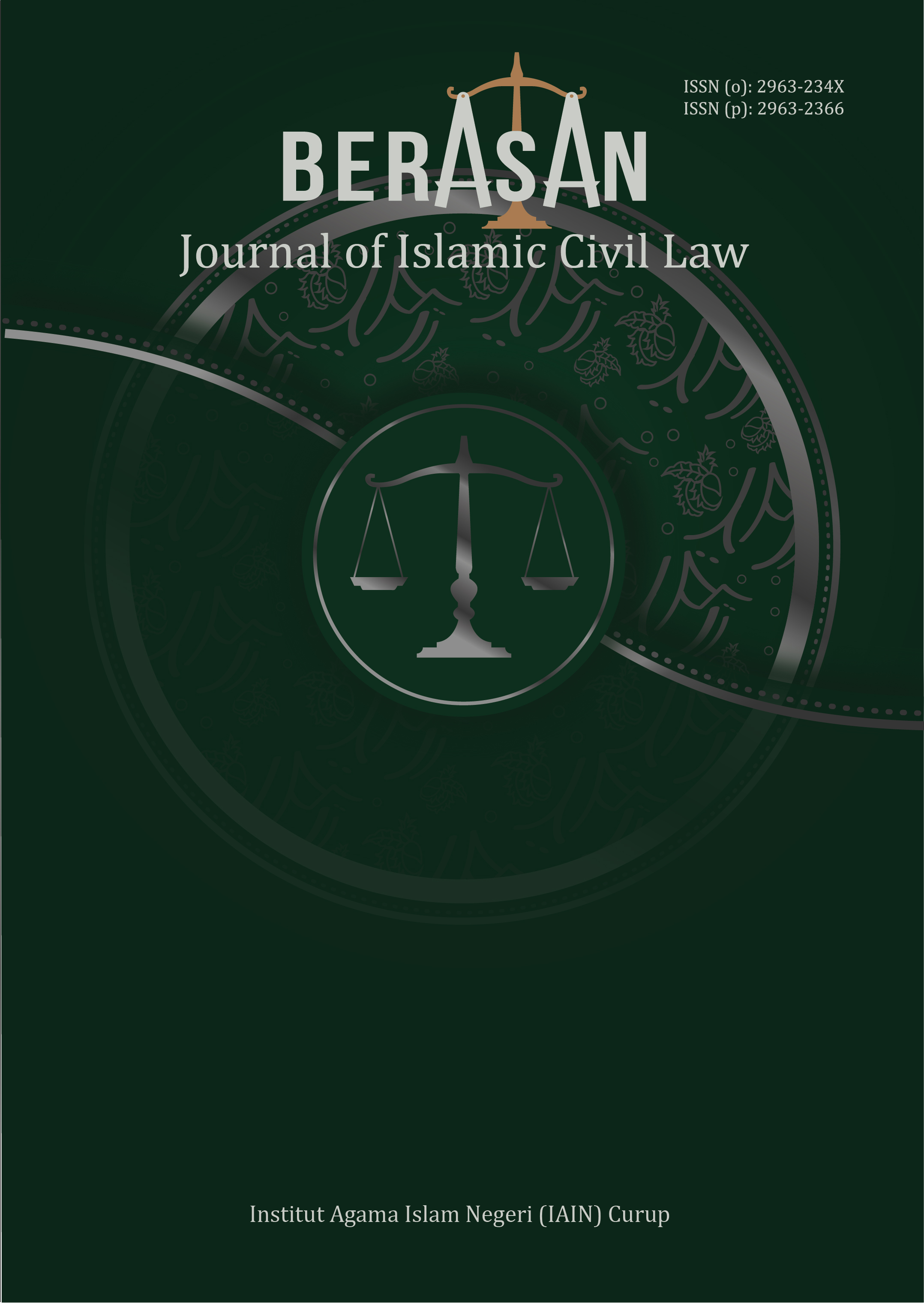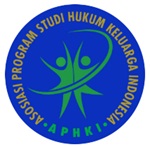Revitalisasi Nilai Islam dalam Adat Perkawinan pada Tradisi Piti Rambang
DOI:
https://doi.org/10.29240/berasan.v3i2.11753Keywords:
Marriage, Islam, Piti Rambang, PernikahanAbstract
This study aims to analyze the practice of Piti Rambang in the perspective of Islamic civil law, as well as how the revitalization of Islamic values can be applied to harmonize customs with the principles of justice and protection of women's rights. This study uses an analytical descriptive method with a normative-empirical approach. The normative approach is carried out through the study of Islamic law, the Marriage Law, and human rights law in Indonesia. Meanwhile, an empirical approach is carried out through secondary data analysis related to Piti Rambang's practices, interviews with traditional leaders, academics, and women activists in Sumba. The results of the study show that the practice of Piti Rambang is contrary to the basic principles of marriage in Islam, which emphasizes the willingness of both parties (ridha) and gender justice. In national law, this practice violates the provisions of Article 6 of Law Number 1 of 1974 concerning Marriage, which requires the consent of both prospective brides. In addition, Piti Rambang can also be categorized as a violation of human rights and kidnapping based on Articles 328 and 333 of the Criminal Code. As an effort to revitalize Islamic values in marriage customs, it is necessary to carry out a reconstruction of customary law that is more oriented towards the values of sakinah, mawaddah, wa rahmah, as well as education to the public about women's rights in marriage. Local governments, religious leaders, and women's protection institutions must play an active role in conducting socialization and advocacy to ensure that Islamic customs and laws can run in harmony without harming certain parties, especially women.
Downloads
References
Abu Dâwud, Sulaimân bin al-Asy`ats. Sunan Aby Dâwud Ma`a `Awn Al-Ma`bud. India: Al-Mathba`ah Al-Anshâriyah, 1323.
Al-Bukhâriy, Abû `Abdullâh Muhammad bin Ismâ`il. Shahîh Al-Bukhâriy. Mesir: Al-Suthaniyah, 1311.
Al-Nasâ’iy, Abu `Abdurrahmân Ahmad bin Syu`ayb. Sunan Al-Nasâ’iy. 1st ed. Kairo: Al-Maktabah al-Tijariyah al-Kubra, 1930.
Al-Turmudziy, Muhammad bin `Isa. Sunan Al-Turmudziy. Beirut: Dar al-Gharb al-Islamiy, 1996.
Anggraini, Siska Ayu, Rachmat Panca Putera, Hukum Keluarga Islam, Universitas Islam Lampung, and Universitas Islam Lampung. “Konsep Legalitas Perkawinan Dalam Kompilasi Hukum Islam : Kajian Hukum Dan Sosial.” AL FUADIY : Jurnal Hukum Keluarga Islam 5, no. 2 (2023): 71–83.
Dewi, Dian Kemala. “Tradisi Kawin Tangkap Sumba Dan Prespektif Undang-Undang R I Nomor 1 Tahun 1974 Tentang Perkawinan.” Law Jurnal 2, no. 2 (2022): 107–15. https://doi.org/10.46576/lj.v2i2.1812.
DJU BIRE, CHATRYEN M., and Melinda Ratu Radja. “Perlindungan Hak Perempuan Berdasarkan Convention on Elimination of All Forms of Discrimination Againts Women (Cedaw) Dalam Tradisi Kawin Tangkap Di Sumba.” Jurnal Hukum Samudra Keadilan 18, no. 1 (2023): 131–41. https://doi.org/10.33059/jhsk.v18i1.7473.
Doko, Elanda Welhelmina, I Made Suwitra, and Diah gayatry Sudibya. “Tradisi Kawin Tangkap (Piti Rambang) Suku Sumba Di Nusa Tenggara Timur.” Jurnal Konstruksi Hukum 2, no. 3 (2021): 656–60. https://doi.org/10.22225/jkh.2.3.3674.656-660.
Ibn Mâjah, Muhammad bin Yazid. Sunan Ibn Mâjah. Beirut: Dar al-Risalah, 2009.
Indrama, Dedi. “Tradisi Kawin Tangkap Di Tinjau Dari Perspektif Hukum Islam.” Al-Risalah: Jurnal Hukum Keluarga Islam (Ahwal Al-Syakhsiyah) 3, no. 1 (2022): 82–93. https://doi.org/10.30863/al-risalah.v3i1.2150.
Khoiruddin, Muhammad. “Wali Mujbir Menurut Imam Syafi’I (Tinjauan Maqâshid Al-Syarî’Ah).” Al-Fikra : Jurnal Ilmiah Keislaman 18, no. 2 (2020): 257. https://doi.org/10.24014/af.v18i2.8760.
Muslim bin al-Hajjâj, Abû al Husayn. Shahîh Muslim. Turki: Dar al-Thaba`ah al-`Amirah, 1335.
Naray, Averina LO, Harly S Muaja, and Anna Wahongan. “Delik Penculikan Dalam Pasal 328 Kuhp Sebagai Suatu Kejahatan Terhadap Kemerdekaan.” Lex Administratum 5, no. 5 (2022).
Nurhaliza, Puan, Lily Andayani, and Aliesa Amanita. “Tinjauan Yuridis Terhadap Tradisi Kawin Tangkap Di Sumba Ditinjau Dari Undang-Undang.” Jurnal Rechswetenschap Abstrak, 2024.
Rakhmat, Dengan, Tuhan Yang, Maha Esa, and Presiden Republik Indonesia. “UU No. 1 Tahun 1974 Tentang Perkawinan,” 1974, 1–15.
Suhartawan, Budi. “Hak Dan Kewajiban Suami Istri Dalam Perspektif Al-Qur’an:(Kajian Tematik).” Tafakkur: Jurnal Ilmu Al-Qur’an Dan Tafsir 2, no. 2 (2022): 106–26. http://e-jurnal.stiqarrahman.ac.id/index.php/tafakkur/article/view/65.
Sunarti, Gustiya. “Usia Minimal Kawin Menurut Undang-Undang Nomor 16 Tahun 2019 Atas Perubahan Undang-Undang Nomor I Tahun 1974 Tentang Perkawinan Dalam Perspektif Maslahah Murshalah.” Qiyas 6, no. 2 (2021).
TARAMBANI, UMBU RUSDYANTO. “AGENDA SETTING PEMBENTUKAN PARTAI POLITIK ALTERNATIF:UPAYA MEMBANGUN PARTAI MASSA RAKYAT OLEH KESATUAN RAKYAT (Studi Penelitian Kualitatif Di Kesatuan Perjuangan Rakyat Badan - Pekerja Yogyakarta),” August 1, 2022.
Umah, Habibah Nurul. “Fenomena Pernikahan Dini Di Indonesia Perspektif Hukum-Keluarga-Islam.” Jurnal Studi Hukum Islam 5, no. 2 (2020): 112–112.
Downloads
Published
Versions
- 2025-02-12 (2)
- 2025-02-10 (1)
Issue
Section
Citation Check
License
Copyright (c) 2025 Harry Yuniardi

This work is licensed under a Creative Commons Attribution-NonCommercial-ShareAlike 4.0 International License.
Authors who publish with Berasan: Journal of Islamic Civil Law agree to the following terms:
- Authors retain copyright and grant the journal right of first publication with the work simultaneously licensed under a Creative Commons Attribution-NonCommercial-ShareAlike 4.0 International License (CC BY-NC-SA 4.0) that allows others to share the work with an acknowledgment of the work's authorship and initial publication in this journal.
- Authors are able to enter into separate, additional contractual arrangements for the non-exclusive distribution of the journal's published version of the work (e.g., post it to an institutional repository or publish it in a book), with an acknowledgment of its initial publication in this journal.
- Authors are permitted and encouraged to post their work online (e.g., in institutional repositories or on their website) prior to and during the submission process, as it can lead to productive exchanges, as well as earlier and greater citation of published work (See The Effect of Open Access).









